List of national instruments (music)
This list contains musical instruments of symbolic or cultural importance within a nation, state, ethnicity, tribe or other group of people.
In some cases, national instruments remain in wide use within the nation (such as the Puerto Rican cuatro), but in others, their importance is primarily symbolic (such as the Welsh triple harp). Danish ethnologist Lisbet Torp has concluded that some national instrument traditions, such as the Finnish kantele, are invented, pointing to the "influence of intellectuals and nationalists in the nationwide promotion of selected musical instruments as a vehicle for nationalistic ideas".[1] Governments do not generally officially recognize national instruments; the only exceptions are the Paraguayan harp,[2] the Japanese koto[3] and the Trinidadian steelpan.[4]
This list compiles instruments that have been alleged to be a national instrument by any of a variety of sources, and an instrument's presence on the list does not indicate that its status as a national instrument is indisputable, only that its status has been credibly argued. Each instrument on this list has a Hornbostel-Sachs number immediately below it. This number indicates the instrument's classification within the Hornbostel-Sachs system (H-S), which organizes instruments numerically based on the manner in which they produce sound.[5]
Images and recordings are supplied where available; note that there are often variations within a national musical tradition, and thus the images and recordings may not be accurate in depicting the entire spectrum of the given nation's music, and that some images and recordings may be taken from a region outside the core of the national instrument's home when such distinctions have little relevance to the information present in the image and recordings. A number of countries have more than one instrument listed, each having been described as a national instrument, not usually by the same source; neither the presence of multiple entries for one nation, nor for multiple nations for one instrument, on this list is reflective of active dispute in any instance. Alternative names and spellings are given. These mostly come from alternative spellings within English or alternative methods of transliterating from a foreign language to English, such as the Chinese yangqin, also transliterated yang ch'in and yang qin. Others reflect regions or subcultures within a given nation, such as the Australian didgeridoo which is or has been called didjeridu, yidaki, yiraki, magu, kanbi and ihambilbilg in various Australian Aboriginal languages. All non-English words are italicized.
| Nation | Instrument | Description Recording |
H-S number | Image |
|---|---|---|---|---|
| Afghanistan | rubab[6][7] rabab |
Short-necked three-stringed lute with sympathetic and drone strings, fretted and plucked with a plectrum, with a double-chambered body, the lower part of which is covered in skin, and with three main strings | 321.321-6 | 
|
| Albania | Çiftelia Gajde Lahuta |

| ||
| Arab | oud[8] |
Pear-shaped fretless stringed instrument, with five courses of two strings and a single eleventh string, a bent back and a bowl-shaped body, often with up to three soundholes, played with a pick | 321.321-6 | — |
| Argentina | bandoneón[9][10] |
Button accordion with a box shape, played with both hands using buttons that produce two sets of notes per hand | 412.132 | |
| Argentina | guitar[11][12] |
Fretted stringed instrument with a hollow body and a soundboard | 321.322 | 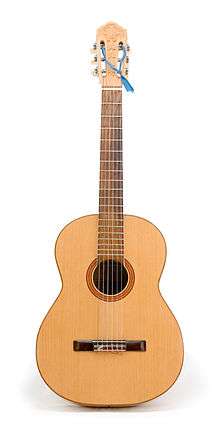
|
| Armenia | duduk[7] daduk |
Double-reed pipe with wide reeds made from pieces of cane in a duckbill-type assembly, generally diatonic and with a single octave range | 421.211.12 | 
|
| Australian, Indigenous | didgeridoo[13][14] didjeridu, yidaki, yiraki, magu, kanbi, ihambilbilg |
Straight trumpet without fingerholes, traditionally made from a trunk or thick branch of a tree, sometimes with a rim of beeswax around the blowing end, requires circular breathing | 423.121.11 | — |
| Azerbaijan | balaban[15][16] |
Set of cylindrical shawm-like instruments, with an air reservoir like a bagpipe | 422.121-62 | |
| Baganda peoples of Uganda | endongo[17] |
Bowl lyre made of lizardskin with strings tied to a piece of wood inserted into two holes on two arms | 321.21 | — |
| Balochs | suroz[18] |
Bowed string instrument with a long neck, similar to a fiddle or sarangi and played vertically | 321.322 | — |
| Bangladesh | dotara[19] |
Small stringed instrument, with plucked metal strings, elongated belly as soundboard and narrow neck ending in a pegbox, decorated with carvings of animals and covered with skin | 321.322 | — |
| Bashkir | kurai[20][21] |
Long open endblown flute with five fingerholes | 421.111.12 | — |
| Basotho | lesiba[22] |
Stringed instrument, blown rather than plucked or strummed, with a single string and tuning noose attached both to a bow and a feather quill, with a frame made from a coconut shell | 311.121.222 | — |
| Bavaria | zither[23][24] Volkszither |
Stringed instrument with a soundbox, with strings stretched across it, originally with four melody strings and no more than fifteen accompaniment strings | 314.122 | |
| Bhutan | dranyen[25] dranyen, dramnyen |
Seven-stringed lute, fretless, long-necked and double-waisted with rosette-shaped sound hole | 321.321 | — |
| Bolivia | charango[26] charanga |
Fretted, hollow-bodied bowl lute, usually with four or five doubled strings, with as many as eleven tunings, traditionally made from an armadillo shell | 321.321-6 | |
| Brazil | guitar[27] violão |
Fretted seven-stringed instrument with a soundboard and a hollow body, originally with steel strings, but now more commonly with nylon | 321.322 | 
|
| Brazil | berimbau[28] |
Single-stringed musical bow |
311.121.221 | |
| Brazil | pandeiro[29] |
Handheld frame drum with metal jingles (platinelas) attached, tuned through adjusting the tension of the head, can also be shaken or rasped | 211.311 + 112.122 |
|
| Bulgaria | gaida[30] |
Bagpipe with three types of chanters, one a simple reed, open at one end, another a small, conical tube with eight fingerholes, one of which is the flea-hole (a small hole made out of a tube that can raise any note a half-step), and the last is a long, no-holed drone | 422.22-62 | 
|
| China | guqin[31][32] qin |
A plucked seven-string zither with open strings and a range of about four octaves | 312.22 | 
|
| China | guzheng[33] zheng, gu-zheng |
Half-tube zither, rectangular with three sound holes on the bottom, now with twenty-one strings most typically, pentatonic tuning, strings are plucked by hand | 312.22-5 | 
|
| China | pipa[34] |
Pear-shaped bowl lute with a neck, played by plucking | 321.321-5 | — |
| China | yangqin[7] yang ch'in, yang qin |
Hammered dulcimer, with a trapezoidal sounding board and traditionally bronze strings, struck with rubber-tipped bamboo hammers | 314.122-4 | |
| Colombia | cuatro[35] |
Fretted stringed instrument with a hollow body and with four strings | 321.322 | 
|
| Colombia | tiple[36] |
Four-stringed small fretted instrument with a hollow body | 321.322 | 
|
| Costa Rica | marimba[37] |
Xylophone-like instrument with gourd resonators, two sets of overlapping keys, struck with mallets | 111.222-4 | |
| Corsica | cetera ceterina, cetara |
A musical instrument of the cittern family, common in Corsica. | 111.224-4 | 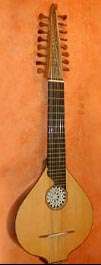
|
| Crete | lyra[38] |
Three-stringed fretted, pear-shaped instrument with a hollow body and a vaulted back, propped up on the knee | 321.21 | — |
| Croatia | {{{Name}}} tamburitza |
Lute-like stringed instrument with a long neck, picked or strummed, variable number of strings | 321.321 | 
|
| Cuba | tres[39] |
Guitar-like instrument with a neck and three courses of two strings each | 321.322 | — |
| Dagara peoples of Ghana | gyil[40] |
Xylophone-like calabash gourd with holes covered in spider silk, wooden frame, struck with a hammer | 111.222-4 | 
|
| Ecuador | rondador[41][42] |
Set of chorded bamboo panpipes that produces two tones simultaneously, consisting of pieces of cane, placed side by side in order by size and closed at one end, played by blowing across the top of the instrument | 421.112.11 | |
| Egypt, Ancient | harp[43] |
Open harp, used in widely varying forms, though originally semi-circular and with five to seven strings, number of strings increased over time, while the size decreased | 322.12 | — |
| Egypt, Ancient | sistrum[44] |
U-shaped frame drum with small rings that make sound when shaken | 112.112 | |
| England | bell[45] |
Round framed idiophone, open on one end, with a clapper inside |
111.242.122 | |
| Etruria | kithara[46] |
Stringed instrument with a deep soundbox made of two tables, connected by ribs, with strings attached to a tuning bar, played with a plectrum | 321.22 | 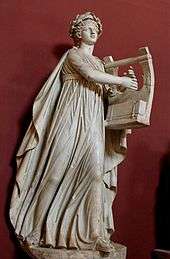
|
| Finland | kantele[1][47][48][49][50] kannel |
Zither–harp, traditionally with five strings, now with up to thirty, held in the lap | 314.122 | |
| Finland, especially Swedish-speaking Finns | violin[50][51] |
Four stringed instrument, bowed, hourglass-shape and an arched top and back |
321.322 | 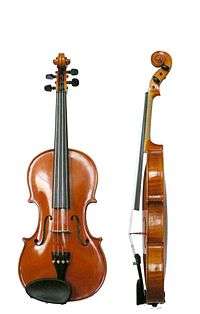
|
| Fula | tambin[52][53] sereendu, fulannu |
Diagonal diatonic flute without a bell, made from a conical vine, with three finger-holes and a rectangular embouchere with two wings on either side | 411.111.22 | — |
| Galicia | gaita[54][55] gaita de fole, gaita gallega |
Diatonic bagpipe with a conical chanter and at least one bass drone, used to accompany both spiritual and secular, as well as lyric and dance music, usually accompanied by a drum (tambour) | 422.211.2-62 | |
| Germany | waldzither[56] German lute, also applied to the lute guitar |
Cittern with nine steel strings; tuned C, G G, C C, E E, G G; famous for allegedly been played by Martin Luther at the Wartburg | 321.322 | 
|
| Greece, Ancient | aulos[57] auloi |
Highly variant double-shawm with a cylindrical bore | 422.121 | 
|
| Greece, Ancient | lyre[58][59] |
Stringed instrument, strummed with a plectrum, with the free hand silencing unwanted strings, traditionally made from a tortoise shell | 321.21 | 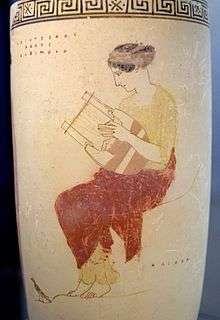
|
| Greece, Modern | bouzouki[1] |
String instrument with a pear-shaped body and a long neck, played with plectrum | 321.321 | |
| Guatemala | marimba[60][61] |
Xylophone-like instrument with gourd resonators, struck with mallets, with a two level keyboard so it can play the full chromatic scale | 111.222-4 | |
| Hawaii | ukulele[62] |
String instrument derived from the Portuguese braguinha, from the Hawaiian uku lele, jumping flea, referring to the swift fingerwork the instrument requires |
321.322 | 
|
| Hungary | cimbalom[63] czimbalom, cymbalom, cymbalum, ţambal, tsymbaly, tsimbl, santouri, santur |
Chromatic hammered dulcimer with four legs | 314.122-4 | |
| India | veena[64] vina |
Semitonically fretted lute with a long, cylindrical shape, resting on two gourds | 311.222 | |
| Indonesia | angklung[65][66] |
Two bamboo tubes, closed at one end and with tongues, attached to a square frame, played by shaking from side to side, causing the tongues to vibrate | 112.122 | |
| Iran | santur[67] |
Hammered dulcimer, trapezoidal-shaped with 72 strings and two sets of bridges, hit with mallets | 314.122-4 | — |
| Ireland | Irish Harp(Cruit or Cláirseach) {{{Other names}}} |
Polychord wire-strung harp with a fore-pillar | 322.221 | 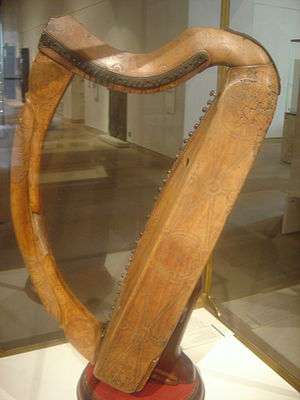
|
| Ireland | Great Irish Warpipes Píob Mhór {{{Other names}}} |
In modern times this instrument is essentially identical to the Great Highland Bagpipe | {{{Number}}} | — |
| Ireland | Uilleann Pipes Píobaí Uilleann, Union Pipes {{{Other names}}} |
Pump blown Bagpipe | {{{Number}}} | — |
| Israel | kinnor[68] David's harp |
Biblically described historic instrument, probably a cithara; in modern Hebrew, refers to the violin | 321.22 | 
|
| Italy | mandolin[69] |
Stringed instrument |
321.321 | |
| Japan | koto[70] |
Long and hollow thirteen-stringed instrument | 312.22-7 | |
| Jewish | shofar[71] |
Horn, flattened by heat and hollowed, used for more religious than purely secular purposes, made from the horn of an animal, most typically a ram or kudu | 423.121.1 | |
| Kazakhstan | dombra[72][73] |
Fretted, long-necked lute with a round body, played by plucking with a plectrum | 321.321-6 | |
| Kenya | nyatiti[74][75][76] |
3-foot-long (0.91 m) harp, plucked with both hands, made of wood and goat or antelope skin | 321.21-5 | — |
| Khoikhoi | goura[77] |
Single stringed instrument, blown rather than plucked or strummed, with the string attached to a coconut shell resonator and with a tension noose wrapped around the string to adjust the pitch | 311.121.222 | — |
| Korea | gayageum[78][79] kayagum, kayago |
zither-like string instrument, with 12 strings. | 312.22-5 | |
| Kyrgyzstan | komuz[80][81] |
Three-stringed fretless lute, made from wood with gut strings | 321.321 | 
|
| Lanna (Northern Thailand) | pin pia[82] |
Chest-resonated stick zither with two to five strings | 311.221 | — |
| Laos | khene[83] khaen |
Mouth organ with bamboo tubes, attached in pairs to the mouthpiece, and with fixed free reeds | 412.132 | 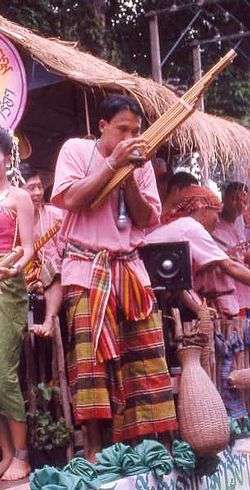
|
| Latvia and Latvian-Americans | kokle[84][85] |
Diatonic, lute-like string instrument | 314.122 | |
| Lebanon | darbuka[86] debakeh |
Goblet-shaped hand drum | 211.261.21 | |
| Lithuania | birbyne[87] |
Aerophone, can be single- or double-reed, with or without a mouthpiece | 422 | — |
| Lithuania | kanklės[88] |
Stringed instrument | 314.122 | |
| Lobi peoples of Ghana | gyil[40] |
Keyed calabash gourds with holes covered in spider silk, wooden frame | 111.222-4 | 
|
| Madagascar | valiha[89][90] |
Tubular zither | 312.11 | 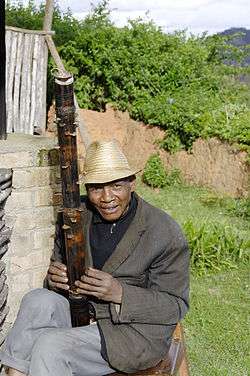
|
| Mandinka of West Africa | balo[91][92] behlanjeh |
Set of wooden pieces, mounted on gourds, in a frame and played using two rubber-tipped mallets, held in hands with iron cylinders and rings attached to add a jingling sound | 111.212 + 112.111 |
— |
| Maroons of Jamaica | abeng[93] |
Aerophone made from the end of a cow horn with the tip broken off on the side, which is blown into | 423.122.2 | — |
| Mexico | marimba[94] |
Xylophone-like instrument with wooden square tubes resonators, struck with mallets, with a two level keyboard so it can play the full chromatic scale | 111.222-4 | |
| Mongolia | morin khuur[95][96] horse-head fiddle, igil |
Two-stringed instrument, held between the legs, with a trapezoidal body and a horse's head typically carved on the upper edge of the pegbox | 321.322 | |
| Montenegro | gusle[97] |
Stringed instrument, round, typically with one string bound at the top of the neck with a tuning peg | 321.321-71 | — |
| Myanmar | saung-gauk[98] saung, Burmese harp |
Arched harp with sixteen strings, attached to the harp with red cotton tassels | 322.11 | — |
| Nepal | madal[99] |
Double-headed cylindrical drum, slightly bulging at the waist, held horizontally and played double-handed | 211.212.1 | — |
| Netherlands | fiddle[100] |
Four-stringed instrument, bowed | 321.322 | — |
| Nicaragua | marimba[101] |
Xylophone-like instrument with gourd resonators | 111.222-4 | |
| Norway | Hardingfele[47][102][103] Hardanger fiddle |
Ornately decorated fiddle with four main strings and four resonating strings beneath them, which are not touched by the bow | 321.322-71 | .jpg)
|
| Norway | langeleik[47] |
Rectangular zither with five or six strings, one melody string and several drone strings | 314.122 | |
| Pakistan | Dafli Daf |
The dafli, also popularly known as daf, dappler or tambourine, is a must for weddings. Made of wooden ring with a double row of bells and a playing surface with a 10" diameter, our dafli is a perfect accompaniment to the dholki. The pleasant sound of the dafli will elevate the tempo and mood of all celebrations. Easy to play with no beforehand practice required - with these daflis anyone can add to the music played in weddings and other celebrations. | ? | |
| Paraguay | harp, Paraguayan[104][105][106] |
Diatonic harp with 32, 36, 38 or 40 strings, made from tropical wood and with songs in the Guarani language, with an exaggerated neck-arch, played with the fingernail | 322.211 | — |
| Peru | cajón[107][108] |
Wooden box with a hole in one side, derived from containers used to transport agricultural products by portworkers | 111.221 | 
|
| Peru | charango[109] charanga, chillador |
Guitar-like instrument, most commonly with ten strings in two courses and made from an armadillo back | 321.321-6 | 
|
| Philippines | Rondalla[110] |
rondalla tradition of ensemble playing of plucked instruments including bandurias, octavinas, laúds, guitars, and basses. | 321.321 | — |
| Polynesia | nose flute[111] |
Flute, made from a single piece of bamboo, with three holes to blow into from the nostrils, with fingerholes | 421.111.22 | |
| Portugal | Portuguese guitar[112] |
Fretted stringed instrument with a hollow body | 321.322 | |
| Puerto Rico | cuatro[113] |
Fretted stringed instrument with a hollow body, derived from the Spanish tiple and other stringed instruments, made from carved wood with strings (ten, in five sets of two) of leather strips or dried animal gut | 321.322 | |
| Rome, Ancient | tibiae[114] |
Double-reed shawm, played paired | 422.122 | — |
| Russia | accordion[115] |
Accordion, bellow-driven free reed with keys or buttons to modify the air flow |
412.132 | 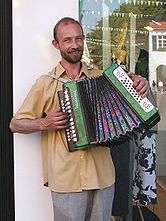
|
| Russia | balalaika[7] |
Family of triangle-shaped lute-type instruments | 321.32 | 
|
| Russia | gusli[116] |
Zither-like instrument with between eleven and thirty-six strings, tuned diatonically | 314.122 | |
| Russia | spoons[117] |
Painted wooden teaspoons, used as a percussion instrument | 111.141 | — |
| Ryukyus of Japan | sanshin[118] |
Three stringed banjo-like instrument, covered with snakeskin | 321.312-6 | 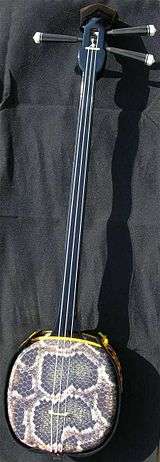
|
| Sakha | khomus[119] |
jaw harp, made from a reed attached to a frame, plucked | 121.221 | |
| Scotland | bagpipe, highland[1][120][121] |
Bagpipe with a chanter, blowpipe, two tenor drones and a bass drone | 422.112.2-62 + 422.221.1-621 |

|
| Serbia | Accordion[122] |
Accordion, bellow-driven free reed with keys or buttons to modify the air flow |
412.132 | — |
| Serbia | frula[123] |
End-blown wooden flute with six fingerholes | 421.211.12 | — |
| Serbia | gajda[30] Surle |
Bagpipe with three types of chanters, one a simple reed, open at one end, another a small, conical tube with eight fingerholes, one of which is the flea-hole (a small hole made out of a tube that can raise any note a half-step), and the last is a long, no-holed drone | 422.22-62 | 
|
| Serbia | gusle[124] |
Stringed instrument, round, typically with one string bound at the top of the neck with a tuning peg |
321.321-71 | 
|
| Slovakia | fujara[125][126] |
Endblown long bass diatonic fipple flute | 421.211.12 | 
|
| Slovenia | accordion[127] |
Accordion, bellow-driven free reed with keys or buttons to modify the air flow |
412.132 | |
| South Africa | Vuvuzela Kuduzela |
Straight plastic natural horn | 423.121.12 | — |
| Spain | guitar[12][128] |
Fretted stringed instrument, long-necked with a flat soundboard and back, and incurved sides | 321.322 | 
|
| Sweden | drejelire[47][50] |
Hurdy-gurdy that uses a rosined wheel to create sound | 321.322-72 | 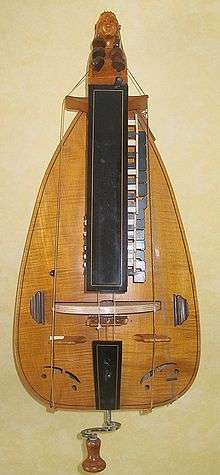
|
| Sweden | nyckelharpa[47][129] |
Bowed keyed fiddle | 321.322-71 | |
| Swedish Estonia | talharpa[130] |
Bowed lyre with no fingerboard | 321.22-71 | — |
| Switzerland | alphorn[131][132] |
Long wooden conical trumpet, bent at the end, with turned boxwood mouthpieces, traditionally used by herdsmen | 423.121.12 | |
| Trinidad and Tobago | steelpan[4][133][134] |
Barrel-shaped percussion instruments, tuned chromatically, originally made from discarded 55 gallon drums | 111.241.2 | 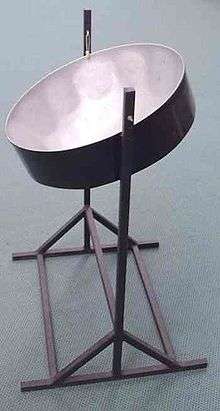
|
| Turkey | saz[135][136] bağlama, kopuz |
Fretted lute with a long neck, pear-shaped body, and three courses of seven steel strings | 321.321-6 | |
| Turkmenistan | dutar[137] |
Plucked string instrument with two strings and a long neck, strummed or plucked | 321.322 | — |
| Tuva | igil[138] Horse-head fiddle |
Small fiddle | 321.322 | 
|
| Tuva | khomus[139] |
Jaw harp, made from a reed attached to a frame, plucked | 121.221 | |
| Tuva | morin khuur[138] Horse-head fiddle |
Large fiddle with a wooden sound box and two strings attached to tuning pegs in the neck | 321.322 | 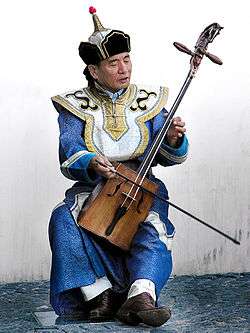
|
| Ukraine | bandura[140] |
Diatonic, unfretted lute-like string instrument, traditionally carved from a single block of wood | 321.321 | — |
| United States, African American in origin | banjo[141][142] |
Four or five stringed instrument, plucked with a bare thumb and a forefinger covered by a metal thimble, traditionally with four or five strings, | 321.312-5 | 
|
| Uzbekistan | doira[143] |
Round, flat drum with shakers made of metal inside and a horse-skin head | 211.311 + 112.113 |
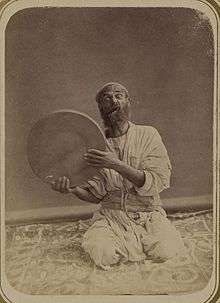
|
| Uzbekistan | karnay[144][145] |
Long brass trumpet with a mouthpiece | 423.121.12 | — |
| Venezuela | cuatro[35][146][147] |
Guitar-like lute with four strings, usually strummed | 321.322 | 
|
| Venezuela | harp, Venezuelan[147] |
Diatonic harp, with an exaggerated neck arch, similar to the Paraguayan harp | 322.211 | 
|
| Vietnam | đàn bầu[148] |
321.22 | — | |
| Wales | crwth[148] |
Six-stringed instrument with a flat fingerboard, fretless | 321.22 | |
| Wales | harp, triple[149][150][151] telyn |
Harp with no blades or levers, with three rows of strings, the outer two tuned in a diatonic scale and the inner one tuned to the extra semitones of the chromatic scale | 322.212.1 | 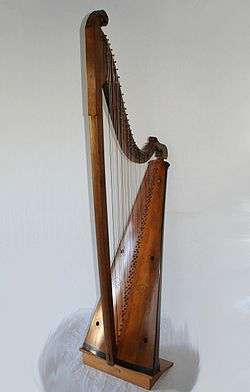
|
| Yugoslavia | gusle[152] |
Stringed instrument, round, typically with one string bound at the top of the neck with a tuning peg |
321.321-71 | 
|
| Zimbabwe | mbira[153][154] thumb piano |
Plucked lamellophone, consisting of staggered keys attached to a board, with a halved calabash gourd as resonator | 122.12 |
References
- 1 2 3 4 Grahn, Göran (April 1999). "Review of Musikkens Tjenere - Instrument - Forsker - Musiker by Mette Müller and Lisbet Torp". The Galpin Society Journal. 52: 367–368. doi:10.2307/842547. JSTOR 842547.
One of the most interesting articles is that by Lisbet Torp about invented traditions in creating a national instrument, such as the Highland bagpipe in Scotland, the kantele in Finland, the bouzouki in Greece etc. She takes the reader through a tour of Europe, in a journey through time and space, beginning in the British Isles at the end of the 18th century with the Irish harp and the Scottish highland bagpipe. She then points to the influence of intellectuals and nationalists in the nationwide promotion of selected musical instruments as a vehicle for nationalistic ideas. The conclusion is that Denmark never developed any national instrument, though, 'at the beginning of the 20th century, the prehistoric bronze lurs were treated as a national symbol.'
- ↑ "Study Guide for Quad City Arts' Visiting Artists Series" (pdf). Quad City Arts. October 2001. Retrieved December 23, 2007.
- ↑ "About the Japanese Koto". KotoWorld. Retrieved December 23, 2007.
- 1 2 Dudley, Shannon; Stuempfle, Stephen (Spring–Summer 1998). "Review of The Steelband Movement: The Forging of a National Art in Trinidad and Tobago by Stephen Stuempfle". Ethnomusicology. Society for Ethnomusicology. 42 (2): 366–368. doi:10.2307/3113905. JSTOR 3113905.
(The book) uses an appropriate approach for the first major work on Trinidad and Tobago's national instrument.
- ↑ von Hornbostel, Erich M.; Curt Sachs (March 1961). "Classification of Musical Instruments: Translated from the original German by Anthony Baines and Klaus P. Wachsmann". Galpin Society Journal. Galpin Society. 14: 3–29. doi:10.2307/842168. JSTOR 842168.
- ↑ Doubleday, Veronica (2000). "Afghanistan: Red Light at the Crossroads". In Broughton, Simon and Mark Ellingham with James McConnachie and Orla Duane (Eds.). World Music: The Rough Guide. Rough Guides. pp. 3–7. ISBN 1-85828-636-0.
Afghans have a special feeling for the rubab, describing it as the 'lion' of instruments and their 'national instrument'.
- 1 2 3 4 ARC music; Peter McClelland. "Glossary of Folk Instruments". Hobgoblin Music. Retrieved December 17, 2007.
- ↑ Project Results (pdf). The Music Inter-Cultural X-Change: Project for Peace in Israelpublisher=The Boston Conservatory. p. 2. Retrieved December 26, 2007.
- ↑ Peiro, Teddy; Jan Fairley (2000). "Argentina: Vertical Expression of Horizontal Desire". In Broughton, Simon and Mark Ellingham with James McConnachie and Orla Duane (Eds.). World Music: The Rough Guide. Rough Guides Ltd. p. 305. ISBN 1-85828-636-0.
- ↑ Troop, William (2007). "Global Hit: Dino Saluzzi" (mp3). The World. PRI. Retrieved December 17, 2007.
(Dino Saluzzi) is a master of Argentina's national instrument, the button accordion known as the bandoneon.
- ↑ Fink, Michael (February 2, 2003). "Assad Duo, guitars with Nadja Salerno-Sonnenberg, violin" (program notes). Retrieved December 21, 2007.
Another folk element is a reference to the guitar, considered a national instrument associated with the gauchos of the Pampas region.
- 1 2 Pinnell, Richard T.; Ricardo Zavadivker (1993). The Rioplatense Guitar. Bold Strummer. ISBN 0-933224-42-7.
- ↑ Neuenfeldt, Karl; Cited to Moyle, 1981 (see Further reading) (1998). "The Quest for a "Magical Island": The Convergence of the Didjeridu, Aboriginal Culture, Healing and Cultural Politics in New Age Discourse" (Reprint). Social Analysis. 42 (2): 73–102. Retrieved December 17, 2007.
It has not been a national instrument until quite recently, the previous range was primarily in the northern third of the continent.
- ↑ Breen, Marcus (2000). Broughton, Simon and Mark Ellingham with James McConnachie and Orla Duane (Eds.), ed. World Music: The Rough Guide. Rough Guides. p. 11. ISBN 1-85828-636-0.
The aura and resonance of the continent the instrument carries means the didgeridoo will never lose its place as the instrument that best reflects the Aboriginals' 50,000 years of tradition and experience.
- ↑ Heumann, Michael (August 16, 2004). "Azerbaijan". Almaty or Bust!. Stylus Magazine. Retrieved December 26, 2007.
(T)he Azeri national instrument is a type of bagpipe called a balaban.
- ↑ Umid, Aysel; Translated by Afina Yagizarova. "Guba: Music". Azerbaijan: The Land of Arts. TUTU Children's Cultural Center. Retrieved February 17, 2008.
- ↑ Wachsmann, Klaus (1964). "The Migration of Musical Instruments: Human Migration and African Harps". Journal of the International Folk Music Council. 16: 84–88. doi:10.2307/835087. JSTOR 835087.
- ↑ Badalkhan, Sabir (October 2003). "Balochi Oral Tradition". Oral Tradition. 18 (2): 229–235. doi:10.1353/ort.2004.0049.
Notwithstanding the emergence of a strong nationalistic feeling among the Baloch population both in Iran and Pakistan, the existence of pahlawan (professional singers of verse narratives), and the love for suroz (a bowed instrument played as an accompaniment to narrative songs and considered to be the national instrument of the Baloch) among the educated classes, there seems to be no future for the oral tradition in Balochistan.
- ↑ Begum, Rumena Mohima. "Musicians Stories". World on Your Street. BBC. Retrieved December 17, 2007.
The dotara is the national instrument of Bangladesh.
- ↑ Seryogina, Olesya (October 24, 2007). "Musician's Seven Kurais". Culture. BASHvest. Retrieved December 26, 2007.
Music performed on this wonderful Bashkir national instrument is understandable and dear to all.
- ↑ Belaiev, Victor (1963). "The Formation of Folk Modal Systems". Journal of the International Folk Music Council. International Council for Traditional Music. 15: 4–9. doi:10.2307/836227. JSTOR 836227.
- ↑ "Traditional Music & Dance". The Drum Cafe. Retrieved December 21, 2007.
Discover the sounds of the lesiba, the Basotho national instrument with its harsh, bird-like sounds.
- ↑ Grove, George (1954). Dictionary of Music and Musicians. St. Martin's Press. ISBN 1-147-22765-9.
The zither may be considered the national instrument of Bavaria
- ↑ "The Concert Zither: A Brief History". Zithers-USA. Zither Newsletter USA. Retrieved February 17, 2008.
- ↑ Broughton, Simon; Mark Ellingham (2000). World Music. James McConnachie. Rough Guides. ISBN 1-85828-636-0.
- ↑ Baumann, Max Peter (1997). "Review of Bolivie: Charangos et guitarrillas du Norte Potosi by Florindo Alvis and Jean-Marc Grassler". Yearbook for Traditional Music. 29 (1997): 200–201. JSTOR 768327.
Among chordophones, the charango has become the Bolivian national instrument par excellence.
- ↑ "Chamber Recital Programme". The Annual Glebe Music Festival. Glebe Music Festival. November 25, 2007. Retrieved December 17, 2007.
Born in Brazil, Murilo Tanouye began his musical pursuit by learning Jazz and Bossa Nova (sic) on the guitar, his country's national instrument.
- ↑ Graham, Richard (Spring–Summer 1991). "Technology and Culture Change: The Development of the "Berimbau" in Colonial Brazil". Latin American Music Review / Revista de Música Latinoamericana. University of Texas Press. 12 (1): 1–20. doi:10.2307/780049. JSTOR 780049.
Although this metamorphosis insured the emerging berimbau a higher social status as a Brazilian national instrument.
- ↑ Ya Salaam, Kalamu. "When Brazil Came Calling" (Reprint). The New Black Magazine. Kalamu. Retrieved December 17, 2007.
- 1 2 "Bagpipes: A blast from the past". Independent.ie. November 30, 2007. Retrieved December 17, 2007.
- ↑ "The Qin". Heilbrunn Timeline of Art History of the Metropolitan Museum of Art.
Endowed with cosmological and metaphysical significance and empowered to communicate the deepest feelings, the qin is the most prestigious of China's instruments.
- ↑ Beijing Review, Issues 27-52. Beijing Review, original from the University of Michigan. 1981. p. 30.
- ↑ "Dong Yi in Zheng Recital at the Great Hall of the People". Link Chinese. Retrieved December 21, 2007.
As the most popular national instrument in China, zheng (also known as gu-zheng) is one of the eldest Chinese string instruments with a history of at least 2,500 years.
- ↑ Millward, James. "From Camelback to Carnegie Hall: the Global Journey and Modern Makeover of the Pipa". AAS Annual Meeting. Retrieved December 22, 2007.
I note the irony of this transformation: the modernization of the pipa as a Chinese national instrument entailed reworking it to fit the musical standards and contexts of polyphonic Western music.
- 1 2 Vandervort, Leland. "Andean Instruments". Musica Andina. Retrieved December 17, 2007.
The cuatro has a very dry sound and is often strummed in syncopation with the rhythm of many musical forms originating from Colombia and Venezuela. The cuatro is also considered the "national instrument" of these two countries.
- ↑ Pinnell, Richard; Zuluaga, David Puerta (Autumn 1993). "Review of Los Caminos del Tiple by David Puerta Zuluaga". Ethnomusicology. 37 (3): 446–448. doi:10.2307/851728. JSTOR 851728.
- ↑ Marrs, Stuart. "Percussion in Costa Rica, 1972-82" (pdf). Percussion Studies. University of Maine. Retrieved December 17, 2007.
After all, the marimba is the "national instrument" of Costa Rica.
- ↑ Dawes, Kevin (October 2003). "Lyres and the body politic: studying musical instruments in the Cretan musical landscape". Popular Music and Society. 26.3 (21): 263–283. doi:10.1080/0300776032000116950.
The island's "national" instrument, the lyra has become emblematic of the struggle that many Cretans experience in their attempt to retain a sense of a local identity.
- ↑ "Nelson Gonzalez". Congahead. Based on an interview with Nelson Gonzalez by Martin Cohenlast=McSweeney. Archived from the original on November 4, 2007. Retrieved December 17, 2007.
The tres is the national instrument of Cuba, and at first glance you'd probably call it a guitar.
|first1=missing|last1=in Authors list (help) - 1 2 "About the Artists". El Taller Latino Americano. Retrieved December 17, 2007.
Gyil,... the grandmother of the keyboard family, is the national instrument of the Dagara and Lobi nations of Ghana in West Africa.
- ↑ Bishop, Douglas. "A Worldwide History of the Panflute". Retrieved December 26, 2007.
This family of pan flutes has many representatives: antara (Quechua) or siku (Aymara), chuli, sanka, malta (the most common variety of siku), toyo (bass siku), and rondador (Ecuador's national instrument, a chorded pan flute).
- ↑ Sargeant, Winthrop (April 1934). "Types of Quechua Melody". The Musical Quarterly. 20 (2): 230–245. doi:10.1093/mq/XX.2.230. JSTOR 738763.
- ↑ Gilman, Daniel Coit, Harry Thurston Peck and Frank Moore Colby (Eds.), eds. (1906). "Egyptian Music". The New International Encyclopedia. Dodd, Mead & Company. p. 712.
Although the harp always remained a national instrument, its popularity was later eclipsed by the lyre.
- ↑ Peck, Harry Thurston (1897). Harper's Dictionary of Classical Literature and Antiquities. Harper & Brothers. ISBN 0-8154-0176-0.
- ↑ Blood, Brian. "Music History Online: Music Before the 16th Century". Dolmetsch Online. Retrieved 2007-12-21.
The British Isles have long been known as the "Ringing Isles" and in the 18th century, the composer Handel cited the bell as the English National Instrument.
- ↑ Lawergren, Bo (January–June 1985). "Musikarchäologie als Traditionsforschung - A Lyre Common to Etruria, Greece, and Anatolia: The Cylinder Kithara". Acta Musicologica. International Musicological Society. 57 (Fasc. 1): 25–33. doi:10.2307/932686. JSTOR 932686.
- 1 2 3 4 5 Isaacson, Lanae H. (Winter 1995). "Folk og Kultur: Arbog for Dansk Etnologi og Folkemindevidenskab". Scandinavian Studies. 67.n1 (2): 142.
Mette Muller's initial essay on the folk musical instruments of Denmark and Scandinavia ("Folk - Folkelig - Folkelige musikinstrumenter i Danmark") circles around the central question of why Denmark did not develop a uniquely national instrument in the same way as Norway (hardingfele and langeleik), Finland (kantele), and Sweden (nyckelharpa and drejelire).
- ↑ Asplund, Anneli (December 2001). "The Kantele: Finland's National Instrument". Virtual Finland. Archived from the original on 2008-05-14. Retrieved December 17, 2007. Archived on May 14, 2008.
(T)he kantele is an essential part of the power of (the Kalevala and thus became), in the 19th century, the Finns' national instrument.
Check date values in:|access-date=(help) - ↑ Moisala, Pirkko (Autumn 1994). "The Wide Field of Finnish Ethnomusicology". Ethnomusicology. Society for Ethnomusicology. 38 (3): 417–422. doi:10.2307/852108. JSTOR 852108.
(Researchers) have run a long-term campaign to introduce the kantele, which has been branded the national instrument of Finland, into every school.
- 1 2 3 Andersson, Otto (October–December 1911). "On Violinists and Dance-Tunes among the Swedish Country-Population in Finland towards the Middle of the Nineteenth Century". Sammelbände der Internationalen Musikgesellschaft. 13 (1): 107–114. JSTOR 929299.
While in Sweden the hurdy-gurdy occupies the rank of a national instrument, like the kantele among the Finns, the Swedish country-population has not adopted either of these instruments, but has instead chosen the violin.
- ↑ Nidel, Richard (2005). World Music: The Basics. Routledge. p. 95. ISBN 0-415-96800-3.
- ↑ Rouget, Gilbert; James Porter (January 1978). "Review of The Peuls by Simha Arom". Ethnomusicology. 22 (1): 224–225. JSTOR 851392.
This proportion is an accurate reflection of the importance of the flute among the Fula; it is, in a sense, their national instrument.
- ↑ Calabash Music. "Fula Flute". National Geographic. Retrieved February 17, 2008.
- ↑ El-Shawan, Salwa; Dorothe Schubarth (1991). "Review of Galicia: Derradeira Polavila". Yearbook for Traditional Music. International Council for Traditional Music. 23: 157–158. doi:10.2307/768420. JSTOR 768420.
The record also features the gaita... which Galicians consider their national instrument
- ↑ Trend, J. B. (January 1924). "Music in Spanish Galicia". Music & Letters. 5 (1): 15–32. doi:10.1093/ml/5.1.15. JSTOR 726256.
- ↑ "Waldzither - Bibliography of the 19th century". Studia Instrumentorum. Retrieved March 23, 2014.
Es ist eine unbedingte Notwendigkeit, dass der Deutsche zu seinen Liedern auch ein echt deutsches Begleitinstrument besitzt. Wie der Spanier seine Gitarre, der Italiener seine Mandoline, der Engländer das Banjo, der Russe die Balalaika usw. sein Nationalinstrument nennt, so sollte der Deutsche seine Laute, die Waldzither, welche schon von Dr. Martin Luther auf der Wartburg im Thüringer Walde (daher der Name Waldzither) gepflegt wurde, zu seinem Nationalinstrument machen. - Liederheft von C. H. Böhm (Hamburg, March 1919)
- ↑ Herzka, H. S. "Dissemination and History". Instruments and Info. Reed Music Tradition. Retrieved December 21, 2007.
For the Greeks, it was the most important of wind instruments, a national instrument. It belonged to the entourage of the god Dionysus, god of fertility, wine, frenzy, ecstasy and rebirth.
- ↑ "Review of Midiaeval Music: An Historical Sketch by Robert Charles Hope" (pdf). Saturday Review of Books and Art. New York Times. December 16, 1899. Retrieved December 21, 2007.
- ↑ Roberts, Helen (February 1981). "Reconstructing the Greek Tortoise-Shell Lyre". Archaeology and Musical Instruments. 12 (3): 303–312. doi:10.1080/00438243.1981.9979805. JSTOR 124242.
- ↑ Stone, Matthew (February 6, 2002). "Indigenous Music of Caribbean Central America". World Beat: Music From Somewhere Else. PopMatters. Retrieved December 17, 2007.
(T)he marimba... has become Guatemala's national instrument.
- ↑ Yurchenco, Henrietta (January 1966). "Review of The Marimbas of Guatemala by Vida Chenoweth". Ethnomusicology. 10 (1, Latin American Issue): 105–106. JSTOR 924197.
(The marimba) is truly a national instrument, enjoyed as much by primitive Indian as by sophisticated urbanite.
- ↑ Cooper, Mike (2000). "Hawaii: Steel and Slide Hula Baloos". In Broughton, Simon and Mark Ellingham with James McConnachie and Orla Duane (Eds.). World Music: The Rough Guide. Rough Guides. p. 56. ISBN 1-85828-636-0.
(Hawaiian craftsmen) began to use local kou and koa wood (in the manufacture of the braguinha) and before long the (ukulele) became a national instrument.
- ↑ Hartmann, Arthur (1916). "The Czimbalom, Hungary's National Instrument". The Musical Quarterly. II (4): 590–600. doi:10.1093/mq/II.4.590. Retrieved December 17, 2007.
(The cimbalom) is the one instrument which so deeply speaks to (the heart of the Hungarian people) which translates the melancholy of the deserts and which in every way expresses (the Hungarian) world of emotions.
- ↑ Frishmuth, Sarah S. (July 1905). "Stringed Instruments". Bulletin of the Pennsylvania Museum. Philadelphia Museum of Art. 3 (11): 45–48. doi:10.2307/3793687. JSTOR 3793687.
India has an infinite variety of lutes, the vina, her national instrument, having a...
- ↑ "Visit by Indonesian Culture and Goodwill Delegate". Campus Flash. Kyoto Sangyo University. July 3, 2007. Retrieved December 26, 2007.
KSU students also enjoyed a performance with the Indonesian national instrument, the Angklung.
- ↑ Perris, Arnold B. (September 1971). "The Rebirth of the Javanese angklung". Ethnomusicology. Society for Ethnomusicology. 15 (3): 403–407. doi:10.2307/850641. JSTOR 850641.
- ↑ Norouzi, Khateren (September 16, 2006). "Iranian Music With Norwegian Radio-Television Symphony Orchestra". Iran Press Service. Retrieved December 26, 2007.
- ↑ "David's Harp". Dolmetsch Online. Retrieved December 21, 2007.
In Hebrew kinnor, also known as David's harp, is the national instrument of Israel.
- ↑ Jahnel, Franz; Nicholas Clarke (2000). Manual of Guitar Technology: Chords Especially for Lefties. Bold Strummer. ISBN 0-933224-99-0.
During the 18th Century (sic), the mandolin became associated with particular Italian districts or regions, and became the national instrument.
- ↑ "Koto". Britannica Concise Encyclopedia. Encyclopædia Britannica. Retrieved March 13, 2008.
- ↑ Wulstan, David (May 1973). "The Sounding of the Shofar". The Galpin Society Journal. Galpin Society. 26: 29–46. doi:10.2307/841111. JSTOR 841111.
It is clear that the word shofar was not used as the name of the Jewish national instrument until comparatively late.
- ↑ Levin, Theodore C. "Kazakhstan". National Geographic World Music. Retrieved December 17, 2007.
(The dombra) has become the national instrument of Kazakhstan.
- ↑ Mirseitova, Sapargul (2005). "Kazakhstan and Its People" (pdf). WLT Kids. World Literature Today. Retrieved February 18, 2008.
- ↑ Nidel, Richard (2005). World Music: The Basics. Routledge. p. 58. ISBN 0-415-96800-3.
Much of Kenya's music is derivative of other Afropop forms, most obviously Congolese, but the singing, high-pitched guitar work, use of the national instrument, the nyatiti (a seven-stringed harp), and bottle percussion give it a unique, identifiable sound.
- ↑ Verjee, Zain (August 30, 1999). "Journey through a rhythm nation". Kenya. BBC News. Retrieved February 19, 2008.
- ↑ Radano, Ronald Michael; Philip Vilas Bohlman (2000). Music and the Racial Imagination. Houston A Baker, Jr. and Houston A. Baker. University of Chicago Press. ISBN 0-226-70199-9.
- ↑ Balfour, Henry (January–June 1902). "The Goura, a Stringed-Wind Musical Instrument of the Bushmen and Hottentots". The Journal of the Anthropological Institute of Great Britain and Ireland. Royal Anthropological Institute of Great Britain and Ireland. 32: 156–176. doi:10.2307/2842910. JSTOR 2842910.
- ↑ "Kayagum 3". Encyclopædia Britannica. Retrieved 2008-05-31.
- ↑ "Kayagum". University of Washington Libraries. Retrieved 2008-05-31.
- ↑ "Cobza". Eliznik. 2005. Retrieved December 21, 2007.
- ↑ Golos, George S. (January 1961). "Kirghiz Instruments and Instrumental Music". Ethnomusicology. Society for Ethnomusicology. 5 (1): 42–48. doi:10.2307/924307. JSTOR 924307.
- ↑ McGraw, Andrew (Summer–Fall 2007). "The Pia's Subtle Sustain: Contemporary Ethnic Identity and the Revitalization of the Lanna 'Heart Harp'". Asian Music. 38 (2): 115–142. doi:10.1353/amu.2007.0035.
- ↑ Morton, David; Brunet, Jacques (September 1974). "Review of Traditional Music of Southern Laos by Jacques Brunet". Ethnomusicology. Society for Ethnomusicology. 18 (3): 472. doi:10.2307/850536. JSTOR 850536.
The "national instrument" of Laos is the khene.
- ↑ Sheeter, Laura (October 29, 2005). "Latvia celebrates national instrument". BBC News. Retrieved December 17, 2007.
Latvia's national instrument (is) the kokle... (which) is reasserting its place at the heart of contemporary Latvian culture.
- ↑ Erdely, Stephen (1979). "Ethnic Music in the United States: An Overview". Yearbook of the International Folk Music Council. International Council for Traditional Music. 11: 114–137. doi:10.2307/767568. JSTOR 767568.
Its revival was initiated (among Latvian-Americans in the United States) in the 1930's (sic) by Latvian folklorists, who claimed it to be their true national instrument.
- ↑ Kerbaj, Mazen (March 2006). "Live in Beirut" (liner notes). Peter Brötzmann and Michael Zerang. Al Maslakh Records. Retrieved December 21, 2007.
Zerang ensorcelled the crowd, especially when he played hard-core rhythms and extended techniques on the Lebanese national percussion instrument, the darbuka (or debakeh).
- ↑ "Lithuania". Baltic and Finno-Ugric. Digelius Nordic Gallery. February 29, 2004. Archived from the original on December 10, 2007. Retrieved December 26, 2007.
- ↑ "The Baltic Countries: Estonia, Latvia and Lithuania". Lithuanian-American Community. August 24, 1998. Retrieved December 22, 2007.
A wooden stringed instrument, similar to the zither, is considered a "national" instrument for all three countries. The Estonian kannel, the Latvian kokles, and the Lithuanian kankles, though similar in design, have distinctive styles.
- ↑ "Afropop Glossary". Afropop. Retrieved December 17, 2007.
zither, national instrument of Madagascar, similar in sound to the kora
- ↑ "Like a God When He Plays". Retrieved December 17, 2007.
- ↑ "The Behlanjeh, the national musical instrument of the Mandingos". Royal Commonwealth Society Library. Cambridge University Library. University of Cambridge. November 5, 2004. Retrieved April 26, 2008.
- ↑ "Balo". Metropolitan Museum of Art. Retrieved April 26, 2008.
- ↑ DjeDje, Jacqueline Cogdell (Spring–Autumn 1998). "Remembering Kojo: History, Music, and Gender in the January Sixth Celebration of the Jamaican Accompong Maroons". Black Music Research Journal. Center for Black Music Research - Columbia College Chicago. 18 (1/2): 67–120. doi:10.2307/779395. JSTOR 779395.
- ↑ "New England Conservatory Presents the World Premiere of Robert Xavier Rodriguez's El Día de los Muertos". Sequenza21. November 15, 2006. Retrieved December 21, 2007.
Eschewing all drums except timpani, the score "utilizes a rich assortment of pitched percussion instruments, with prominent use of two marimbas (the marimba being the national instrument of Mexico as well as an apt musical representation of skeletons)," according to the composer.
- ↑ Pegg, Carole (2000). "Mongolia and Tuva: Sixty Horses in My Herd". In Broughton, Simon and Mark Ellingham with James McConnachie and Orla Duane (Eds.). World Music: The Rough Guide. Rough Guides. pp. 191–192. ISBN 1-85828-636-0.
- ↑ Bayarsaikhan, B.; Jeremy Stoun. Morinkhuur: The Mongolian Horse-head Fiddle (Reprint). Morin Khuur: Self Learning Book. Retrieved December 17, 2007.
(The morin khuur) is the instrument most associated with Mongolian traditions and culture... (W)e hope this book will help foreigners learn to play the Morin Khuur and spread the word about Mongolia's national instrument throughout the world.
- ↑ "Montenegrin Music". Visit Montenegro. Retrieved December 21, 2007.
The beginnings of vocal – instrumental music in Montenegro are neither extravagant nor mystical... the warm sound of fife (reed), patriotic singing of players of gusle (Montenegrin national instrument) or simply a song of the shepherdess in the mountain – were the first, but for Montenegrin music most significant melodic expression.
- ↑ "Arched Harp". Annotated Checklist of Musical Instruments From East Asia on Display at the National Music Museum. National Music Museum. Retrieved December 21, 2007.
This highly decorative harp, formerly associated with the Buddhist dynasties that ruled Burma for centuries, is the national instrument of Myanmar.
- ↑ "Dance & Music". Nepal Dance School. Retrieved December 21, 2007.
The madal is the national instrument of Nepal.
- ↑ Dwight, John Sullivan (1859). Dwight's Journal of Music: A Paper of Art and Literature.
- ↑ "Nicaragua Information". World InfoZone. Retrieved December 17, 2007.
The marimba, an instrument similar to a xylophone, is the national instrument.
- ↑ "Norwegian Hardanger Music and Dance at UMC Feb. 15". UMUC News. University of Minnesota, Crookston. Retrieved December 17, 2007.
The Hardanger fiddle is considered Norway's national instrument.
- ↑ Bjorndal, Arne (1956). "The Hardanger Fiddle: The Tradition, Music Forms and Style". Journal of the International Folk Music Council. International Council for Traditional Music. 8: 13–15. doi:10.2307/834737. JSTOR 834737.
In Norway, the national instrument has come to be the Hardanger fiddle.
- ↑ "The Harp: A Latin American Reinvention". BBC. July 6, 2001. Retrieved December 17, 2007.
In Paraguay, (the harp) became the national instrument.
- ↑ Schechter, John M.; Daniel E. Sheehy; Ronald R. Smith (Spring–Summer 1985). "The New Grove: Latin America". Ethnomusicology. Society for Ethnomusicology. 29 (2): 317–330. doi:10.2307/852145. JSTOR 852145.
The distinctive Paraguayan harp... is featured as lead instrument in hundreds of ensembles in that country, where it is the national instrument.
- ↑ "Paraguayan Harp". Dolmetsch Online. Retrieved December 21, 2007.
(C)haracterized by a large soundbox with a rounded base, very light weight, closely spaced light tension strings (usually nylon), a relatively flat harmonic curve, and with the strings running up through the centre of the neck, which are tuned with gear-style tuners (like a guitar). Almost all harps of this style are played with the fingernails, in very rhythmically intricate music. This is the national instrument of Paraguay, and is commonly found throughout South America, Central America, and in parts of Mexico
- ↑ Rosenberg, Dan. "Afro Peruvian". Afropop. Retrieved December 17, 2007.
These wooden boxes were soon developed into the cajon, the large wooden box that today is the national instrument of Peru.
- ↑ Fairley, Jan (2000). "Andean Music: Beyond the Ponchos". In Broughton, Simon and Mark Ellingham with James McConnachie and Orla Duane (Eds.). World Music: The Rough Guide. Based on an interview with Susana Baca, a Peruvian singer. Rough Guides Ltd. pp. 284–285. ISBN 1-85828-636-0.
- ↑ Bennett, Caroline. "Music in Peru". Viva Travel Guides. Retrieved December 17, 2007.
Native music consists primarily of stringed instruments reminiscent of mandolins and Spanish guitars, including the charanga—Peru's national instrument.
- ↑ Aning, Jerome (November 23, 2007). "Rondalla maestro makes strong pitch for banduria". Inquirer Entertainment. Inquirer. Retrieved December 22, 2007.
A respected rondalla maestro is pushing for the adoption of the banduria as the country's national musical instrument to stimulate interest in its study and cultivation.
- ↑ Person, Adam; Brant Himes; Mike Harris. "Aerophones" (PDF). Ethnic Instruments Catalog. Seattle Pacific University. p. 6. Archived from the original (pdf) on June 10, 2011.
These flutes are found in other regions but particularly in Polynesia where the nose flute is the "national" instrument.
- ↑ "Biographical Notes". XVII Macao Internacional Music Festival. Instituto Cultural do Governo da R.A.E. de Macau. Retrieved December 26, 2007.
His book, The Portuguese Guitar, Lisbon 1999, is the first monograph on this national instrument's origins and historical evolution, iconography, organological study and repertoire.
- ↑ Figueroa, Frank M. (June–July 2002). "The Cuatro: Puerto Rico's National Instrument". Latin Beat Magazine. Archived from the original on December 26, 2007. Retrieved December 17, 2007.
(F)irst and foremost, the cuatro is Puerto Rico's national instrument.
- ↑ Ginsberg-Klar, Maria E. (February 1981). "The Archaeology of Musical Instruments in Germany during the Roman Period". World Archaeology. 12 (3, Archaeology and Musical Instruments): 313–320. doi:10.1080/00438243.1981.9979806. JSTOR 124243.
The tibiae (is) an instrument that may be characterized as the national instrument of the Romans.
- ↑ Von Busack, Richard (August 21–27). "Accordion Manifesto!" (Reprint). Metroactive. North Bay Bohemian. Retrieved February 17, 2007.
In Russia, the accordion is practically the national instrument.
Check date values in:|date=, |year= / |date= mismatch(help) - ↑ Hoerburger, Felix (1952). "Proceedings of the Fourth Conference Held at Opatija, Yugoslavia: Correspondence between Eastern and Western Folk Epics". Journal of the International Folk Music Council. 4: 23–26. JSTOR 835837.
- ↑ "Spoons as Russian Folk Music Instrument". Russia-IC. June 26, 2007. Retrieved December 17, 2007.
- ↑ Tokita, Alison McQueen; David Hughes. "Context and Change in Japanese Music" (pdf). Retrieved December 17, 2007.
(I)n the Ryukyus... the sanshin – the Ryukyuan 'national instrument' and direct ancestor of the shamisen – will be favoured.
- ↑ Balzer, Marjorie Mandelstam (June 1996). "Flights of the Sacred: Symbolism and Theory in Siberian Shamanism". American Anthropologist, New Series. 98 (2): 305–318. doi:10.1525/aa.1996.98.2.02a00070. JSTOR 682889.
- ↑
 Moore, John Weeks (1880) [1854]. "Bagpipe". Complete Encyclopaedia of Music. New York: C. H. Ditson & Company.
Moore, John Weeks (1880) [1854]. "Bagpipe". Complete Encyclopaedia of Music. New York: C. H. Ditson & Company. - ↑ Lysloff, René T. A.; Jim Matson (Spring–Summer 1985). "A New Approach to the Classification of Sound-Producing Instruments". Ethnomusicology. Society for Ethnomusicology. 29 (2): 213–236. doi:10.2307/852139. JSTOR 852139.
- ↑ Broughton, Simon; Mark Ellingham; Richard Trillo (2000). World Music. Rough Guides. p. 274. ISBN 1-85828-635-2.
Its place is now occupied by the accordion which has become the foremost national instrument since its introduction.
- ↑ "Meeting of the Flute - Frula Festival Of Morava". Cultural Corridors of South East Europe. Retrieved December 26, 2007.
Indigenous music performed on the frula – a Serbian national instrument
- ↑ "'Spinning Out of Control': Rhetoric and Violent Conflict" (pdf). June 1, 2006. p. 4. Retrieved December 21, 2007.
The cartoon shows a minuscule Cosic sitting on Milosevic's lap, while the latter is playing the gusle, the Serbian national instrument.
- ↑ "Presidents of Latvia and Slovakia unveil Detva Folklore Festival". Chancery of the President of Latvia. July 8, 2006. Retrieved April 26, 2008.
van Gasparovič presented Vaira Vike-Freiberga with the Slovakian national instrument fujara that has been included in the UNESCO List of the Oral and Intangible Heritage of Humanity in 2005.
- ↑ Randy Raine-Reusch (May 2002). "Fujara - Slovakia". World Instrument Gallery. Retrieved April 26, 2008.
- ↑ Gobetz, Edward. "Acculturation and Assimilation". Slovenian Americans. Multicultural America. Retrieved December 26, 2007.
Since the 1970s there has been an unprecedented surge of interest in Slovenian music (especially the accordion as the national instrument), language, genealogy, history, culture, customs, folklore, and other aspects of Slovenian heritage.
- ↑ Jensen, Melton (September 1994). "Review of Iberia 1990: Otto fantasie per chitarra di autori spagnoli contemporanei by Alís, Bertomeu Salazar, Fernández Alvez, García Abril, Juliá, Marco, Prieto, Ruiz López, Gabriel Estarellas, Angelo Gilardino". Notes. 51 (1): 423–426. JSTOR 899279.
- ↑ Flores, Gypsy (August 3, 2005). "Swirling and Whirling on the Swedish Dance Floor". PopMatters. Retrieved December 21, 2007.
The nyckelharpa is considered Sweden's national instrument.
- ↑ Andersson, Otto (August 1970). "The Bowed Harp of Trondheim Cathedral and Related Instruments in East and West". The Galpin Society Journal. Galpin Society. 23: 4–34. doi:10.2307/842060. JSTOR 842060.
- ↑ Helgelson, Rachel (April 28, 2003). "Switzerland's Music: An Annotated Bibliography". Retrieved December 21, 2007.
The alphorn is considered Switzerland's national instrument.
- ↑ "The Swiss National Instrument". Swiss Alpine Music. Retrieved December 21, 2007.
In 1827 the musicologist Joseph Fétis pronounced the alphorn to be the Swiss national instrument.
- ↑ "NIU Steel Band leaders Teague, Alexis, share honors, dream big about steelpan's place in music world". Northern Illinois University. September 13, 2005. Retrieved December 17, 2007.
(In Trinidad and Tobago), the steel pan was invented and remains the national instrument.
- ↑ Montagu, Jeremy (January–February 1965). "What is a Gong?". Man. Royal Anthropological Institute of Great Britain and Ireland. 65: 18–21. doi:10.2307/2796036. JSTOR 2796036.
- ↑ "Saz". Glossary. National Geographic. Retrieved December 22, 2007.
Considered the national instrument of Turkey.
- ↑ Koprulu, Mehmed Fuad; Devin DeWeese (2006). Early Mystics in Turkish Literature. Translated by Gary Leiser and Robert Dankoff. Routledge. ISBN 0-415-36686-0.
- ↑ "Puppet Theatre". Washington Folk Festival. June 2, 2007. Archived from the original on October 12, 2007. Retrieved December 17, 2007.
There was great admiration for his virtuosity on their national instrument
- 1 2 Wilson, Sue (June 2, 2003). "Yat-Kha, The Ferry, Glasgow". London: The Independent.
Tiuliush also plays the morinhuur and the igil, daddy and baby versions of the Tuvans' national instrument, the horse-headed fiddle, held like a small cello and with two strings, each comprising up to 130 hairs from a horse's tail.
- ↑ Pareles, John (July 10, 1993). "Review of From Half a World Away, Tuva's Unearthly Songs". Review/Music. New York Times. Retrieved December 26, 2007.
The national instrument of Tuva, the khomuz (jaw harp), also depends on a drone and virtuosically shaped overtones, as a solo piece demonstrated on Thursday night.
- ↑ Jarosewich, Irene. "Roman Hrynkiv hopes to give the bandura international stature". Ukraine Weekly. Archived from the original on December 19, 2006. Retrieved December 17, 2007.
The bandura will always be known as Ukraine's national instrument.
- ↑ Hill, Errol; James Vernon Hatch (2003). A History of African American Theatre. Don B. Wilmeth. Cambridge University Press. ISBN 0-521-62443-6.
- ↑ Bailey, Jay (January–March 1972). "Historical Origin and Stylistic Developments of the Five-String Banjo". Journal of American Folklore. American Folklore Society. 85 (335): 58–65. doi:10.2307/539129. JSTOR 539129.
- ↑ Corneli, Zoe (February 22, 2007). "Stanford Pan-Asian Musical Festival". The World. PRI. Retrieved December 17, 2007.
Abbos Kasimov, the premier percussionist from Uzbekistan, is playing his national instrument, the doira.
- ↑ "Rhythms of Uzbekistan: Featuring Shod & Lyazgi". Event Listings. Festival of World Culture. Retrieved April 26, 2008.
- ↑ IA Jahon (August 9, 2007). "'Tashkent' Musicians Capture Attention In UK, Gain Appraisal". Embassy of Uzbekistan in Korea. Retrieved April 26, 2008.
the magic sound of karnay (the Uzbek national music instrument)
- ↑ Lloyd, A. L. (March 1965). "Folklore Tachirense by L. F. Ramon y Rivera and Isabel Aretz". Journal of the International Folk Music Council. 17 (1): 14–15. JSTOR 942277.
This small, four-stringed, guitar-like lute, the national instrument of Venezuela...
- 1 2 Nidel, Richard (2005). World Music: The Basics. Routledge. p. 349. ISBN 0-415-96800-3.
The cuatro rivals the harp as the national instrument
- 1 2 Edgerly, Beatrice (1942). From the Hunter's Bow: The History and Romance of Musical Instruments. G.P. Putnam's Sons.
- ↑ Chorley, Henry Fothergill; Henry G. Hewlett (May 1, 1880). "The National Music of the World". The Musical Times and Singing Class Circular. Musical Times Publications Ltd. 21 (447): 240–241. doi:10.2307/3357258. JSTOR 3357258.
Much is said... about Welsh airs and the national instrument, the harp
- ↑ Marson, John (October 1970). "Reviews of Harp Music". The Musical Times. 111 (1532): 1029–1030. JSTOR 957286.
A people which could cherish the triple harp so long after the rest of the world had dismissed it as obsolete must have more than mere tradition to guide its composers to the national instrument
- ↑ "Triple Harp". Dolmetsch Online. Retrieved December 21, 2007.
Today the triple harp is the national instrument of Wales
- ↑ Lord, Albert B. (1936). "Homer and Huso I: The Singer's Rests in Greek and Southslavic Heroic Song". Transactions and Proceedings of the American Philological Association. The Johns Hopkins University Press. 67: 106–113. doi:10.2307/283230. JSTOR 283230.
- ↑ "Music in Zimbabwe". Nordiska Afrikainstitutet. March 16, 2006. Retrieved December 17, 2007.
The instrument is, in slightly varying forms, several centuries old and is found in many parts of Africa, but only in Zimbabwe has it risen to become something of a national instrument
- ↑ Nidel, Richard (2005). World Music: The Basics. Routledge. p. 81. ISBN 0-415-96800-3.
The mbira is inextricably associated with Zimbabwean traditional music, and is truly the national instrument.
Further reading
- The following are specifically referenced above or are book-length or extended scholarly works documenting a specific national instrument, not including collections of songs.
- African American: Conway, Cecelia (1995). African Banjo Echoes in Appalachia : A Study of Folk Traditions (1st ed.). Knoxville: University of Tennessee Press. ISBN 0-87049-893-2.
- African American: Gura, Philip F.; James F. Bollman (1999). America's Instrument: The Banjo in the Nineteenth Century. University of North Carolina Press. ISBN 0-8078-2484-4.
- African American: Linn, Karen (1994). That Half-Barbaric Twang: The Banjo in American Popular Culture. University of Illinois Press. ISBN 0-252-06433-X.
- Argentina: Muñoz, R. (1952). Technology of the Argentina Guitar. Buenos Aires.
- Argentina: Penón, Arturo; Javier García Méndez; Manuel Román; Marcelle Guertin (1988). The Bandonion: A Tango History, A Memoir of Arturo Penón (Petite histoire du bandonéon et du tango). Translated by Tim Barnard. London, Ontario: Nightwood Editions. ISBN 0-88971-111-9.
- Argentina: Pinnell, Richard T.; Ricardo Zavadivker (1993). The Rioplatense Guitar. Bold Strummer Guitar Study Series: No. 3. Westport, Connecticut: Bold Strummer. ISBN 0-933224-42-7.
- Arab: Bilezikjian, John (2006). Hal Leonard Oud Method. Hal Leonard Corporation. ISBN 0-634-07786-4.
- Armenia: Nercessian, Andy (2001). The Duduk and National Identity in Armenia. Scarecrow Press. ISBN 0-8108-4075-8.
- Australia: Schellberg, Dirk (1994). Didgeridoo: Ritual Origins and Playing Techniques. Binkey Kok. ISBN 90-74597-13-0.
- Australia: Moyle, A. (1981). "The Australian Didjeridu: A Late Musical Intrusion". World Archaeology. 12 (3): 321–331. doi:10.1080/00438243.1981.9979807.
- Baganda (Uganda): Makubuya, James Kika (1995). Endongo: The Role and Significance of the Baganda Bowl Lyre of Uganda. Los Angeles: University of California.
- Bavaria: Alpenfolklorismus, Volksmusik, Bayern-Pop. Niederbayerische Blätter für Volksmusik ; Nr. 7 (in German). Dingolfing: Wälischmiller'sche Buchdruckerei. 1986.
- Brazil: Crowdy, Denis (2001). "Hybridity and Segregation in the Guitar Cultures of Brazil". In Andy Bennett and Kevin Dawe (Eds.). Guitar Cultures. Oxford, New York: Berg. ISBN 1-85973-429-4.
- Brazil: Gregory, Jonathan (2007). A Comprehensive Guide to Brazilian Pandeiro. Booksurge. ISBN 1-4196-7284-3.
- China: Gao, Ming (1980). The Lute: Gao Ming's Pipa Ji (Pi pa ji). Translations from the Oriental Classics. Translated by Jean Mulligan. New York: Columbia University Press. ISBN 0-231-04760-6.
- China: Myers, John (1992). The Way of the Pipa: Structure and Imagery in Chinese Lute Music. Kent, Ohio: Kent State University Press. ISBN 0-87338-455-5.
- Finland: Rahkonen, Carl John (1989). The Kantele Traditions of Finland. Indiana University.
- Ancient Greece: Schlesinger, Kathleen; J.F. Mountford (1970). The Greek Aulos. Groningen: Bouma's Boekhuis. ISBN 90-6088-027-7.
- Guatemala: Armas Lara, Marcial (1964). El renacimiento de la danza guatemalteca y el origen de la marimba. José de Pineda Ibarra (in Spanish). Guatemala, Centro Editorial: Ministerio de Educación Pública.
- Guatemala: Chenoweth, Vida (1964). The Marimbas of Guatemala. Lexington: University of Kentucky Press.
- Guatemala: Pellicer, Sergio Navarrete (2005). Maya Achi Marimba Music in Guatemala. Temple University Press. ISBN 1-59213-292-8.
- Hawaii: Beloff, Jim (1997). The Ukulele: A Visual History. Emeryville, California: Miller Freeman Books. ISBN 0-87930-454-5.
- India: Annapoorna, L. (1996). Veena Tradition in Indian Music. Kanishka. ISBN 81-7391-140-1.
- Ireland: Armstrong, Robert Bruce (1970). The Irish and Highland Harps. Introduction by Seóirse Bodley. New York: Praeger Publishers. ISBN 0-7165-0073-6.
- Ireland: Clark, Nora Joan (2003). The Story of the Irish Harp: Its History and Influence. North Creek Press. ISBN 0-9724202-0-7.
- Ireland: Rimmer, Joan (1969). The Irish Harp. Cork: Mercier Press for the Cultural Relations Committee. ISBN 0-85342-151-X.
- Japan: Adriaansz, Willem (1973). The Kumiuta and Danmono Traditions of Japanese Koto Music. Los Angeles: University of California. ISBN 0-520-01785-4.
- Japan: Johnson, Henry (2004). The Koto: A Traditional Instrument in Contemporary Japan. Hotei. ISBN 90-74822-63-0.
- Japan: Kubota, Hideki (1986). Yakumogoto no shirabe: Shinwa to sono kokoro (八雲琴の調べ : 神話とその心 / 窪田英樹) (in Japanese). Ōsaka-shi: Tōhō Shuppan. ISBN 4-88591-144-3.
- Japan: Wade, Bonnie C. (1976). Tegotomono: Music for the Japanese Koto. Westport, Connecticut: Greenwood Press. ISBN 0-8371-8908-X.
- Latvia: Niles, Christina Jaremko (1980). The Baltic Folk Zithers: An Ethnological and Structural Analysis (Thesis (M.A.)). UCLA.
- Lithuania: Niles, Christina Jaremko (1980). The Baltic Folk Zithers: An Ethnological and Structural Analysis (Thesis (M.A.)). UCLA.
- Mexico: Kaptain, Laurence (1992). The Wood That Sings: The Marimba in Chiapas, Mexico. Everett, Pennsylvania: HoneyRock. ISBN 0-9634060-0-0.
- Mexico: Solís, Ted (1983). The Marimba in Mexico City: Contemporary Contexts of a Traditional Regional Ensemble (Thesis (Ph. D.)). University of Illinois at Urbana-Champaign.
- Mongolia: Marsh, Peter K. (2004). Horse-Head Fiddle and the Cosmopolitan Reimagination of Mongolia. Routledge. ISBN 0-203-00551-1.
- Mongolia: Santaro, Mikhail (2005). Strings That Conquered the World: Morin Khuur, the Mongolian Horse-head Fiddle. Admon. ISBN 99929-0-376-7.
- Norway: Een, Andrea Ruth (1977). Comparison of Melodic Variants in the Hardingfele Repertoire of Norway. University of Illinois at Urbana-Champaign.
- Norway: Goertzen, Chris (1997). Fiddling for Norway: Revival and Identity. University of Chicago Press. ISBN 0-226-30049-8.
- Norway: Hopkins, Pandora (1986). Aural Thinking in Norway: Performance and Communication With the Hardingfele. Foreword by Jan-Petter Blom. Appendix by Magne Myhren. New York: Human Sciences Press. ISBN 0-89885-253-6.
- Portugal: Cabral, Pedro Caldeira (1999). The Portuguese Guitar. Lisbon.
- Sardinia: Bentzon, Andreas Fridolin Weis (1969). The Launeddas: A Sardinian Folk-music Instrument. University of Michigan. Akademisk forlag.
- Scotland: Cannon, Roderick David (2002). The Highland Bagpipe and Its Music. John Donald. ISBN 0-85976-549-0.
- Scotland: Donaldson, William (2000). The Highland Pipe and Scottish Society, 1750-1950: Transmission, Change and the Concept of Tradition. East Linton, East Lothian, Scotland: Tuckwell Press. ISBN 1-86232-075-6.
- Scotland: MacNeill, Seumas; Frank Richardson (1987). Piobaireachd and Its Interpretation: Classical Music of the Highland Bagpipe. Donald. ISBN 0-85976-176-2.
- Scotland: Manson, Wiliam Laird (1901). The Highland Bagpipe: Its History, Literature, and Music. Harvard University. A. Gardner. ISBN 0-7158-1213-0.
- Spain: Schirmer, =G. (1986). Spanish Guitar Music: Guitar Solo. Hal Leonard. ISBN 0-7935-3583-2.
- Spain: Gupta, Rahul (2001). The Symphony Spanish Guitar Book. Gyan Sagar Publication. ISBN 81-7685-015-2.
- Sweden: Ling, Jan (1979). Nyckelharpan: studier i ett folkligt musikinstrument (in Swedish). Prisma.
- Switzerland: Bachmann-Geiser, Brigitte (1999). Das Alphorn : vom Lock- zum Rockinstrument (in German). Bern: P. Haupt. ISBN 3-258-05640-4.
- Trinidad and Tobago: Adams, Norman Darway; Austin O Agho (2005). Stories in Steel: The True Account of the Invention of the Steelpan. Morvant, Trinidad: Jhullian Graphics. ISBN 976-8194-50-2.
- Trinidad and Tobago: Hayward, Rachel (1993). The Steelpan Handbook. Piper Publications.
- Wales: Andersson, Otto Emanuel (1973). The Bowed-Harp: A Study in the History of Early Musical Instruments. Additional footnotes by Kathleen Schlesinger. New York: AMS Press. ISBN 0-404-56503-4.
- Wales: Ellis, Osian (1991). The Story of the Harp in Wales. Cardiff: University of Wales. ISBN 0-7083-1104-0.
- Zimbabwe: Berliner, Paul (1981). The Soul of Mbira: Music and Traditions of the Shona People of Zimbabwe. Berkeley, California: University of California Press. ISBN 0-226-04379-7.
- Zimbabwe: Brenner, Klaus-Peter (1997). Chipendani und Mbira: Musikinstrumente, nicht-begriffliche Mathematik und die Evolution der harmonischen Progressionen in der Musik der Shona in Zimbabwe. Abhandlungen der Akademie der Wissenschaften in Göttingen, Philologisch-Historische Klasse: 3. Folge, Nr. 221 (in German). Göttingen: Vandenhoeck & Ruprecht. ISBN 3-525-82372-X.